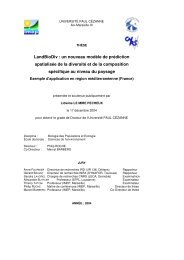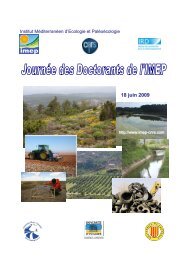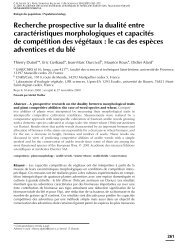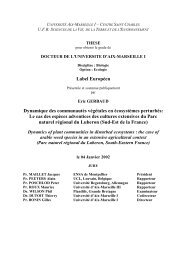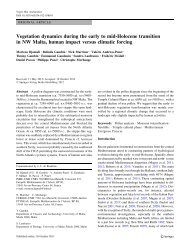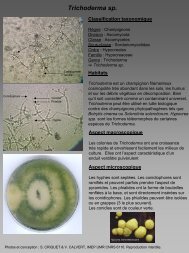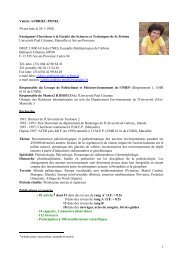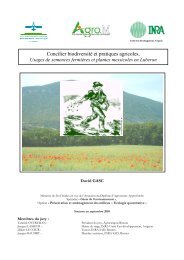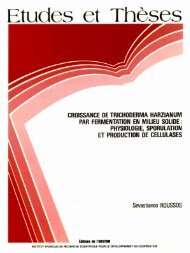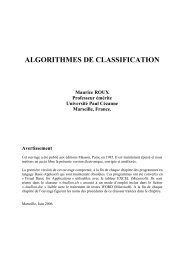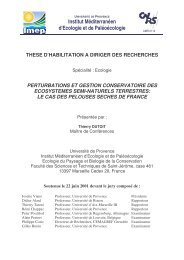UNIVERSITÉ PAUL CÉZANNE, AIX MARSEILLE III - IMEP
UNIVERSITÉ PAUL CÉZANNE, AIX MARSEILLE III - IMEP
UNIVERSITÉ PAUL CÉZANNE, AIX MARSEILLE III - IMEP
Create successful ePaper yourself
Turn your PDF publications into a flip-book with our unique Google optimized e-Paper software.
Résultats et discussion. Chapitre 3: Evaluation des facteurs de croissance<br />
studied. Asymmetrical screening design was established and processing the results with the<br />
Nemrodw software (New Efficient Methodology for Research using Optimal Design) enabled<br />
us to quantify the direct effects of the various factors on the responses chosen and to identify<br />
those that will require fine-tuning during the optimization phase.<br />
2. Materials and methods<br />
2.1. Microorganism and spawn preparation<br />
Single strain of L.edodes (Le119) was used in the experiments. The strain was<br />
maintained at 4 °C on potato dextrose agar (PDA, Sigma, France) supplemented with 10% of<br />
OMW (Lakhtar et al., 2009). Wheat grains (Ebly®, Casino, France) were used as substrate<br />
and growth support for spawn preparation. The grains were cooked for 5 min in a water<br />
solution containing 10% (v/v) of OMW at a ratio of 1:1 (Ebly®: Solution; w: v). Once<br />
cooked, the wheat grains were packaged (250 g of wheat grains in jar of 250 ml) and<br />
sterilized in an autoclave at 121 °C for 30 min. After sterilization, the grains were inoculated<br />
with 5 agar disks of 5 mm diameter containing mycelium and then placed in “Raimbault<br />
columns” (De Araujo et al., 1997) and incubated at 25±2 °C in the absence of light for a<br />
periode of 10 and 25 days.<br />
2.2. Preparation of substrates<br />
The substrates were composed of different parts; OC, olive twigs and leaves (OTL)<br />
and OMW as wetting agent. OC was dried in greenhouse retaining 10% of humidity (w/w).<br />
OC and OMW used throughout the study were taken from a three phase system used in the<br />
conventional press type olive oil mill plant (Beni-Mellal, Morocco). The OC and OTL were<br />
dried in solar greenhouse with 10% (w/w) of moisture retained. OMW was stored at -20°C<br />
until it was used. OMW dilutions were performed in distillate water, unless otherwise stated.<br />
The OTL were ground and sieved to desirable particle size. The individual ingredients of the<br />
substrate were mixed thoroughly by mechanical means to achieve a homogenous mixture.<br />
2.3. Formulation of substrate for L. edodes culture<br />
In order to determine the optimal formulation of substrates allowed for high mycelia<br />
biomass, different mixtures of OC and OTL (max. particle size: 5 mm) were soaked with 50%<br />
(v/v) of OMW to obtain 50% of moisture (Table 1). Sterilization was carried out at 121°C for<br />
30 min. After cooling, 5g of grains of wheat spawn (15 days age) added to 45 g of sterile<br />
substrate were gently mixed and placed in sterile 200 mL Erlenmeyer flask. The Erlenmeyer<br />
flasks were then incubated at 25±2 °C for 1 month. Mycelial biomass was estimated using<br />
93



